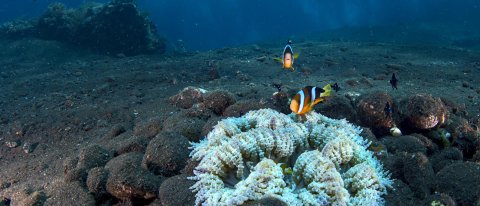If you watched Blue Planet II, the “Green Seas” episode featured intensely productive coastal and inland marine zones in temperate latitudes, where seasonal cycles of heavy plankton and seaweed growth resulting in dynamic conditions underwater.
The Pacific Northwest, referring to the Pacific coast of the northwestern region of North America including Washington, Oregon, Northern California, and British Columbia, is a prime example of these green seas.
Each year, the summer return of long sunlit days and large inputs of nutrients and minerals from land and deep water upwellings fuel an exponential burst of life, beginning with single-celled phytoplankton (diatoms and others). The complex marine food chain rejoices in these plentitudes, all the way up to the largest living species on our planet (whales).
What does this mean for diving? Summer is a wonderful time to get on or in the water in the PNW. Depending on location, surface water temperatures can rise from a tepid ~12ºC (low 50s ºF) to almost 20ºC (near 70ºF!) This is great if you’re a bare-skinned swimmer, or diving in a wetsuit.
But the visibility deteriorates from June through August. In areas where silt and excess nutrients (some, but not all of human origin) flow in from rivers, farms and wastewater systems, you might not be able to see your own hands underwater, let alone your dive buddy. A thick carpet of micro sea life thrives in the first ~10-20 metres of the water column (~30-70 ft). Getting under it is key to see much on a typical summer SCUBA dive.
Here is a display of diver-submitted visibility observations at the Keystone Jetty for the past few years, courtesy of the highly useful and active pnwdiving.com website:
The data clearly show a drop in the diving visibility in the summer months, from about May thru August. By the end of summer, the party’s over for plankton, and the diving visibility improves–sometimes more than doubling! (To be clear, “visibility” here refers to approximately how far we think we can see underwater.)
Seasoned local divers here, especially those in drysuits, have learned to appreciate certain months like April and September for their magical combination of exceedingly pleasant conditions above and below. September is still technically summer, going by celestial definitions (the summer equinox occurs on Sept 21), and is often cited as Washington’s best month of the year.
Here is a view of the visibility at the Keystone Jetty back in late May 2024, the last day of good visibility there before the summer bloom cycle ensued:
Winter is rumored to be good in the PNW as well, however this is site-dependent–to be discussed later.



. Phytoplankton/algae are chlorophyll masters too Chlorophyll levels via remote sensing on [NANOOS Explorer](https://nvs.nanoos.org/Explorer). Phytoplankton/algae are chlorophyll masters too](/posts/pnw-late-summer-vis/nanoos-chl_hu_bb7917e9b73333d9.jpg)

. Phytoplankton & algae ♥ nutrients. Nitrate levels on [NANOOS Explorer](https://nvs.nanoos.org/Explorer). Phytoplankton & algae ♥ nutrients.](/posts/pnw-late-summer-vis/nanoos-nit_hu_ea2376503915f774.jpg)

) Visibility at Keystone Jetty ([pnwdiving.com](https://pnwdiving.com))](/posts/pnw-late-summer-vis/pnwvischart_hu_196382ec0069b5ab.jpg)